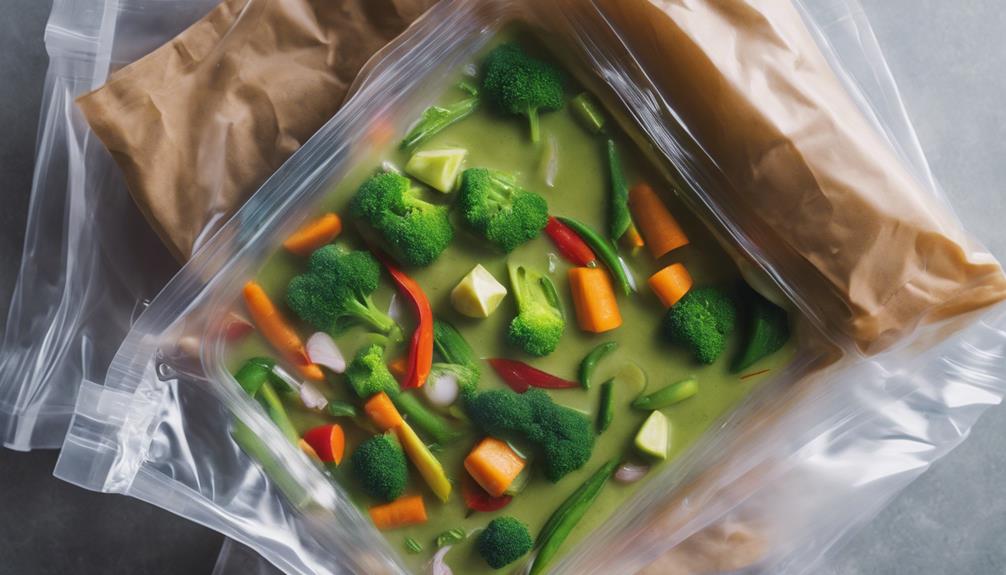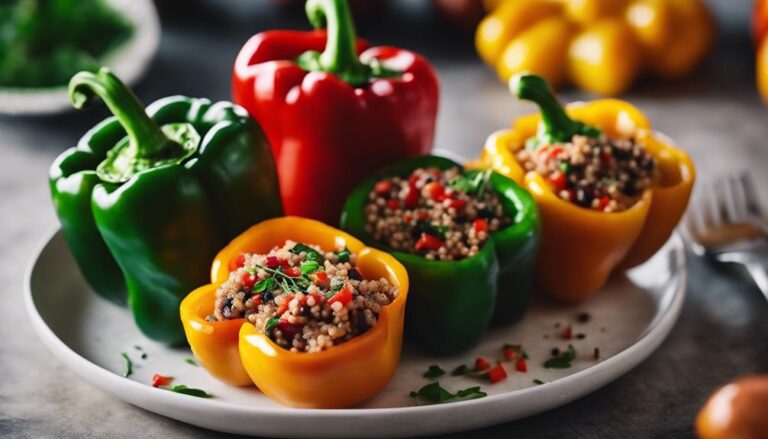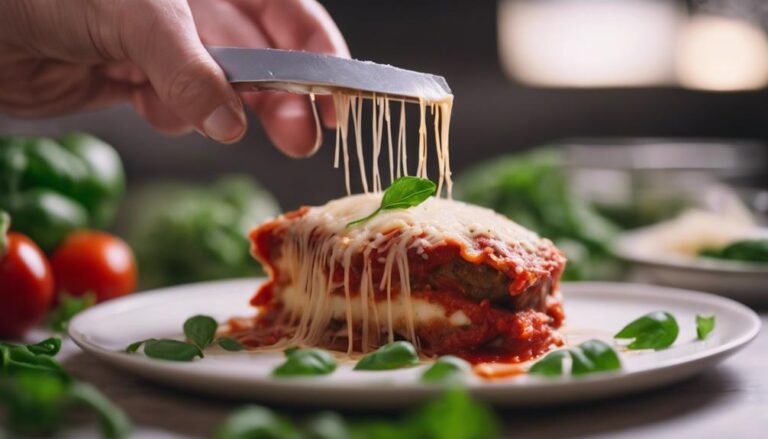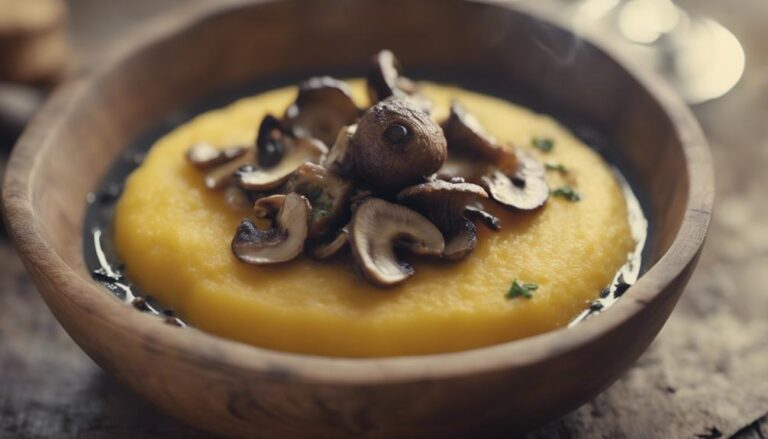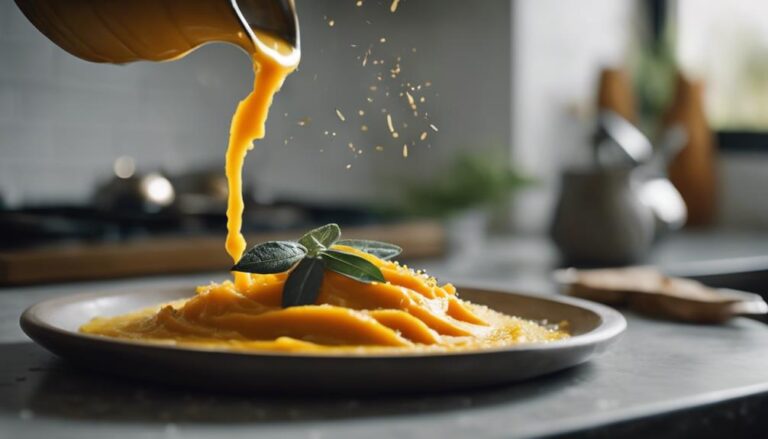Sous Vide Thai Green Curry With Vegetables
Immerse yourself in the rich flavors of Thai green curry with an innovative twist — sous vide technique. Elevate your vegetable curry to new heights by infusing every bite with depth and complexity. The controlled temperature guarantees each ingredient shines, preserving their vibrant colors and textures. Experience the magic of tender vegetables enveloped in a velvety coconut milk broth, harmoniously infused with lemongrass and aromatic spices. Discover how sous vide reveals a symphony of flavors in your green curry, offering a culinary journey like no other. Tap into the full potential of your curry by exploring this modern cooking approach.
What You Will Learn Here
- Sous vide maintains vegetable integrity and vibrant flavors.
- Customize spice levels and add lime for personalized taste.
- Experiment with cooking times for desired texture and flavor.
- Utilize high-quality ingredients like coconut milk and fresh vegetables.
- Achieve perfect balance of sweet, sour, salty, and spicy flavors.
Origin of Thai Green Curry
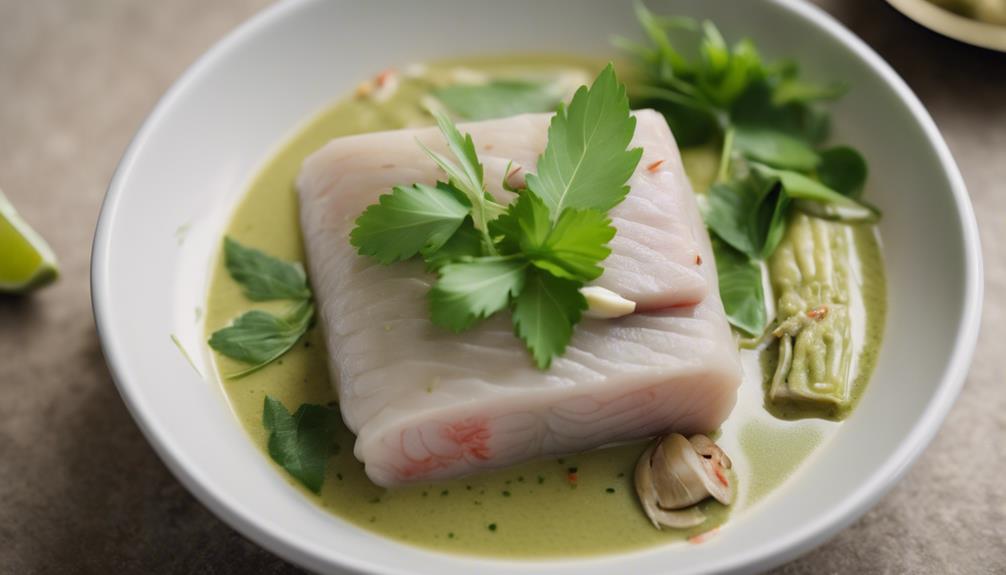
Thai Green Curry is a staple in Thai cuisine. It boasts a vibrant mix of ingredients like green chilies, lemongrass, and kaffir lime leaves. The traditional cooking methods involve pounding the ingredients into a fragrant paste before simmering with coconut milk.
The distinct flavor profile of Thai Green Curry combines spiciness, sweetness, and herbal notes, creating a harmonious balance that's both aromatic and delicious.
Thai Curry Ingredients
With origins tracing back to the lush landscapes of Southeast Asia, this vibrant green curry boasts a medley of aromatic spices and fresh herbs.
When it comes to curry paste options, you have the choice between making your own from scratch using ingredients like green chilies, lemongrass, and coriander, or opting for store-bought versions for convenience. The curry paste is the heart of the dish, providing the signature flavor profile that sets Thai green curry apart.
As for vegetable variations, you can customize your curry with an array of options such as bamboo shoots, bell peppers, eggplant, and zucchini. These vegetables not only add texture and color but also enhance the overall taste of the dish, offering a delightful interplay of flavors in every bite.
Traditional Cooking Methods
Tracing the evolution of Thai green curry back to its traditional cooking methods reveals a rich tapestry of culinary heritage and techniques that have shaped this beloved dish.
Slow cooking plays a pivotal role in the creation of Thai green curry, allowing the flavors to meld together over time, resulting in a complex and harmonious taste profile.
Additionally, the roasting methods employed in preparing the curry paste contribute a depth of flavor that's characteristic of this dish.
The slow simmering of ingredients like lemongrass, kaffir lime leaves, and green chilies allows for the infusion of flavors, creating a fragrant and vibrant curry.
These traditional cooking methods highlight the meticulous attention to detail and the artistry involved in crafting authentic Thai green curry.
Flavor Profile Characteristics
Investigating the flavor profile characteristics of Thai green curry reveals a symphony of vibrant and aromatic notes that define its origin and essence.
Thai cuisine is renowned for its balance of flavors, combining taste preferences for sweet, sour, salty, and spicy elements.
The distinct aroma of Thai green curry comes from a harmonious blend of aromatic spices like lemongrass, galangal, and kaffir lime leaves, reflecting cultural influences that prioritize fresh ingredients and bold flavors.
The cooking techniques used in preparing Thai green curry involve pounding the ingredients into a paste to release their essential oils, resulting in a rich and complex flavor profile that tantalizes the taste buds.
This combination of taste preferences, cultural influences, aromatic spices, and cooking techniques gives Thai green curry its unique and irresistible appeal.
Key Curry Components
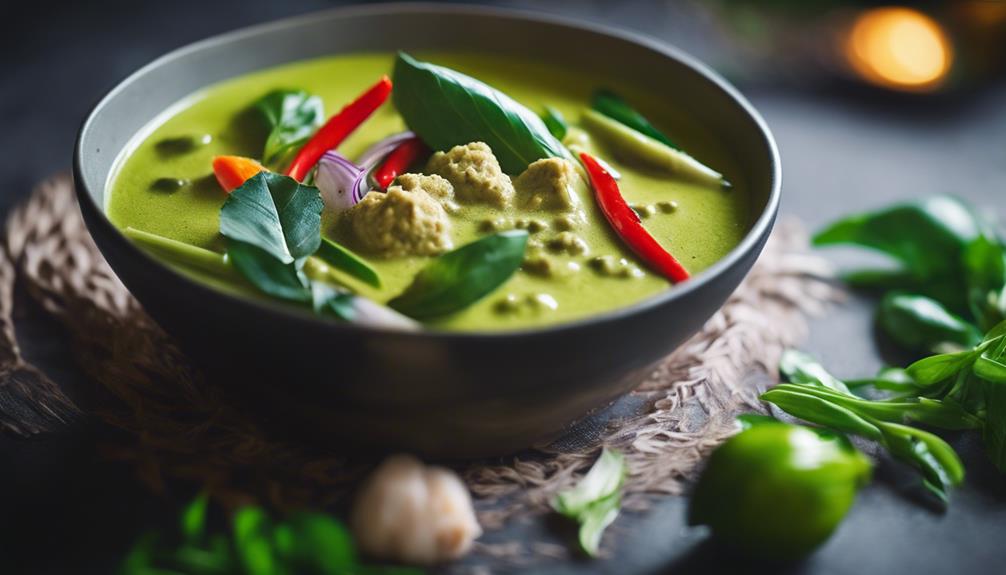
Selecting the right combination of fresh herbs and spices is vital for creating a flavorful and aromatic Thai green curry. When preparing this dish, paying attention to key components and utilizing proper cooking techniques can elevate the overall taste experience. Here are three essential elements to keep in mind:
- Fresh Herbs: The use of fresh herbs like lemongrass, Thai basil, and kaffir lime leaves adds a vibrant and citrusy flavor profile to the curry. These herbs are essential in providing the authentic Thai taste that sets this dish apart.
- Spices: Ingredients such as green chilies, coriander seeds, and cumin not only contribute to the heat level of the curry but also offer complex layers of flavor. Balancing the spices is crucial to achieving a harmonious blend of tastes.
- Coconut Milk: A key component in Thai green curry, coconut milk brings creaminess and sweetness to the dish. It helps mellow out the heat from the chilies and binds all the flavors together, resulting in a luscious curry base.
Top Thai Green Curry Picks
When it comes to Thai green curry, the top picks often revolve around the classic Green Curry Chicken recipe, a flavorful and traditional choice.
Vegetarians might lean towards the Vegetarian Green Curry recipe, packed with fresh veggies and aromatic herbs.
Another popular option is the Coconut Milk-Based Curry recipe, offering a creamy and indulgent twist on the beloved dish.
Green Curry Chicken Recipe
Among the top choices for Thai green curry picks, the Green Curry Chicken recipe stands out for its flavorful blend of spices and tender chicken pieces. Here are three reasons why this recipe is a must-try:
- Authentic Flavors: The Green Curry Chicken recipe captures the authentic taste of Thai green curry with its perfect balance of spicy, sweet, and creamy flavors.
- Versatile Chicken: This recipe allows for various chicken variations, such as using boneless thighs for a juicier texture or opting for chicken breast for a leaner option.
- Customizable Ingredients: Enjoy the freedom to experiment with flavor customization and ingredient substitutions to cater to your preferences, whether you prefer extra heat from more green chilies or a milder taste by adjusting the coconut milk ratio.
Vegetarian Green Curry Recipe
To explore a vegetarian twist on the traditional Green Curry Chicken recipe, contemplate trying out the Vegetarian Green Curry Recipe, a delightful alternative brimming with vibrant flavors and wholesome ingredients. Here are some key points to contemplate when making this dish:
- Tofu Substitute: Swap out the chicken for cubed tofu to add a protein-packed element to your curry while keeping it vegetarian-friendly.
- Green Curry Variations: Experiment with different vegetables like bell peppers, zucchini, or bamboo shoots to create a colorful and nutritious dish that suits your taste preferences.
- Spice Level: Adjust the amount of green curry paste to control the spiciness of the dish, allowing you the freedom to tailor it to your desired heat level.
This Vegetarian Green Curry Recipe offers a creative and delicious way to enjoy the flavors of Thai cuisine without the meat.
Coconut Milk-Based Curry Recipe
For a decadent twist on Thai cuisine, immerse yourself in the rich flavors of Coconut Milk-Based Curry, a top contender in the domain of Thai Green Curry picks. This creamy and aromatic dish offers a delightful experience for your taste buds. Here's why you should consider this option:
- Vegan Substitutions: Coconut milk serves as a perfect vegan alternative to traditional dairy-based curries, ensuring a luscious and cruelty-free meal.
- Alternative Proteins: Tofu or tempeh can be excellent protein sources in this curry, absorbing the flavors and adding a satisfying texture to each bite.
- Versatility: The velvety coconut milk base allows for a versatile dish where you can easily customize with your favorite vegetables or proteins, making it a go-to option for a quick and flavorful meal.
Enhancing Curry Flavor Profiles
When aiming to enhance curry flavor profiles, consider spice pairing tips to elevate the taste experience.
Your ingredient selection can make a significant impact on the overall depth and complexity of the dish.
Understanding cooking techniques can help you achieve the perfect balance of flavors in your Thai green curry.
Spice Pairing Tips
Enhance the vibrant flavors of your Thai green curry by skillfully pairing spices that enhance its complex profile. When it comes to spice pairing, thoughtful combinations can truly amplify the depth and complexity of your curry. Here are some tips to help you enhance your dish:
| Spice | Flavor Profile | Best Pairing |
|---|---|---|
| Lemongrass | Citrusy, herbal | Galangal, Kaffir lime leaf |
| Thai Basil | Sweet, peppery | Cilantro, Mint |
| Cumin | Earthy, nutty | Coriander, Turmeric |
Experimenting with different spice pairings can reveal new dimensions in your curry. By understanding the flavor profiles and mastering the art of spice pairing, you can create a Thai green curry that is truly exceptional.
Ingredient Selection Guide
To elevate the flavor profiles of your Thai green curry, carefully select ingredients that harmonize and enhance the overall taste experience. Ingredient pairing is essential; choose fresh Thai basil, lemongrass, and kaffir lime leaves for an authentic aroma.
Opt for high-quality coconut milk to achieve a rich and creamy texture, while adding depth with fish sauce and a touch of palm sugar for balancing sweetness.
When selecting vegetables, consider using a mix of vibrant bell peppers, bamboo shoots, and Thai eggplants to create a colorful and flavorful dish.
Cooking tips include lightly toasting the curry paste before adding other ingredients to enhance its aroma and depth of flavor. Remember, the key to a delicious Thai green curry lies in the thoughtful selection and combination of ingredients.
Cooking Technique Insights
For an intensified depth of flavor in your Thai green curry, consider implementing a slow cooking technique to infuse the dish with rich, complex taste profiles.
Utilizing sous vide benefits the curry by allowing the flavors to meld together harmoniously over an extended period. The gentle cooking process guarantees that the vegetables retain their nutrients and vibrant colors while absorbing the fragrant green curry sauce.
To enhance the flavor further, experiment with different cooking times to find the perfect balance between tenderness and flavor infusion. Longer cooking times can intensify the spices and aromatics, while shorter times may preserve the freshness of the ingredients.
Final Thoughts
In the end, what truly enhances this Sous Vide Thai Green Curry With Vegetables is the harmonious blend of vibrant flavors and perfectly tender vegetables. The precision of the sous vide technique guarantees that each vegetable maintains its integrity while absorbing the rich coconut milk and aromatic spices, resulting in a dish that bursts with freshness and complexity.
For those looking to explore, ingredient variations such as swapping out the vegetables for ones of your preference or adding proteins like tofu or shrimp can provide exciting twists to this classic dish. Cooking tips like adjusting the cooking time slightly to achieve your desired vegetable texture can further personalize your culinary experience.
When it comes to flavor customization, don't be afraid to play with the spice levels or add a squeeze of lime for a tangy kick. Presentation ideas like serving the curry in hollowed-out coconuts or over a bed of jasmine rice can add a touch of elegance to your dining table. Let your creativity guide you as you immerse into the world of sous vide cooking with this vibrant Thai green curry.
Frequently Asked Questions
Can I Substitute the Vegetables in This Recipe With Other Options?
You can definitely switch up the veggies in this recipe for a different twist. Experiment with bell peppers, snap peas, or even baby corn. These swaps can bring new flavors and textures to the dish.
Is There a Difference in Flavor if I Use Homemade Curry Paste Versus Store-Bought?
When comparing flavor, using homemade curry paste offers a fresher, more vibrant taste with customizable spice levels. Store-bought versions may lack complexity but provide convenience. Experiment with both to find your preferred balance of flavor and convenience.
Can I Use a Different Protein Besides Tofu in This Recipe?
You can certainly swap tofu for various proteins in this dish. Consider chickpeas, tempeh, or seitan for alternative textures and flavors. Vegetarian alternatives like these guarantee a hearty meal with a different protein twist.
How Long Can I Store Leftover Thai Green Curry in the Fridge?
You can store leftover Thai green curry in the fridge for up to 3-4 days. Keep it in an airtight container. Reheat gently on the stove or microwave. Serve over fresh rice or noodles to enjoy its flavors fully.
Are There Any Recommended Side Dishes or Accompaniments to Serve With This Curry?
When enjoying your curry, consider pairing it with wine like Riesling or Gewürztraminer. Spice up dessert choices with mango sorbet or coconut ice cream. Cocktail-wise, try a lemongrass martini. Vegetable garnishes like crispy shallots or fresh cilantro add extra flair.
Conclusion
Overall, the sous vide Thai green curry with vegetables is a flavorful and aromatic dish that combines traditional Thai ingredients with modern cooking techniques.
The tender vegetables and perfectly cooked protein create a harmonious balance of flavors and textures.
By using the sous vide method, the curry is able to retain its vibrant colors and bold flavors, making it a standout dish that's sure to impress both novice and experienced cooks alike.
